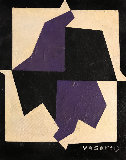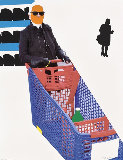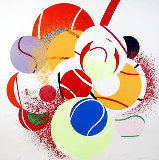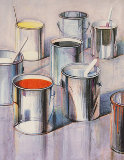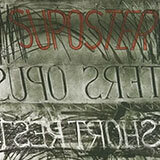





Twelve Forms Derived From a Cube - F1 PP 1984
Sol LeWitt
Limited Edition Print : Screenprint in Colors on Arches 88 Paper
Size : 8x8 in | 20x20 cm
Framed : 16x16 in | 41x41 cm
Edition : Printers Proof
Reduced
-
🔥Limited Editiin Screenprint - Blue Chip $$$$$$$
Year1984
Hand SignedLower Right and on Verso
Condition Excellent
Framed with PlexiglassIn New Ebonized Wood Frame, Floated With an 8 Ply
Purchased fromAuction House 2018
Story / Additional InfoA signed and numbered screenprint by Sol LeWitt, this print comes from the 1984 portfolio entitled, "Twelve Forms of Derived From a Cube." The complete portfolio consists of 48 prints (4 variations of 12 different forms). Published by Multiples Inc. (NYC) and Marilena Bonomo (Bari, Italy), and printed by Jo Watanabe Studios (NYC) in an edition of 40, with 10 artist's proofs, 2 printer's proofs and 4 trial proofs.
Certificate of AuthenticityArt Brokerage
LID129449
Sol LeWitt - United States
Art Brokerage: Sol LeWitt American Blue Chip Artist: b. 1928-2007. Sol LeWitt was born in Hartford, Connecticut in 1928, the son of Russian Jewish immigrants. He was raised by his mother and his aunt following his father's death when he was six. As a child, he enjoyed drawing on the blank sheets of wrapping paper in his aunt's store and attending art classes at the Wadsworth Atheneum. LeWitt completed a traditional art program at Syracuse University in 1949 and served in the Korean War as a graphic artist. In 1953 he moved to New York and held a variety of short-term jobs, including working as a night receptionist at the Museum of Modern Art, while developing alternatives to what he called "the useless ideas of Abstract Expressionism." He began making simple geometric paintings in series, which became the basis of his art. In the early 1960's, LeWitt extended these ideas to three- dimensional wooden forms or "structures." Bothered by their inconsistencies, he stripped the wooden skin off these structures to reveal the sculpture's skeletal core. He also developed a prescribed ratio that he followed, which determined the amount of open space versus the amount of support structure in each piece. This focus on highly conceptual relationships, with increasing complexity and variation, has continued to guide his work as a sculptor. The cube provided a particularly rich form for this kind of exploration and has been the focus of his attention for decades. He has been equally concerned with expanding the parameters of two-dimensional work, creating drawings and paintings that are applied directly to the wall and that transform entire architectural environments. Listings wanted.




